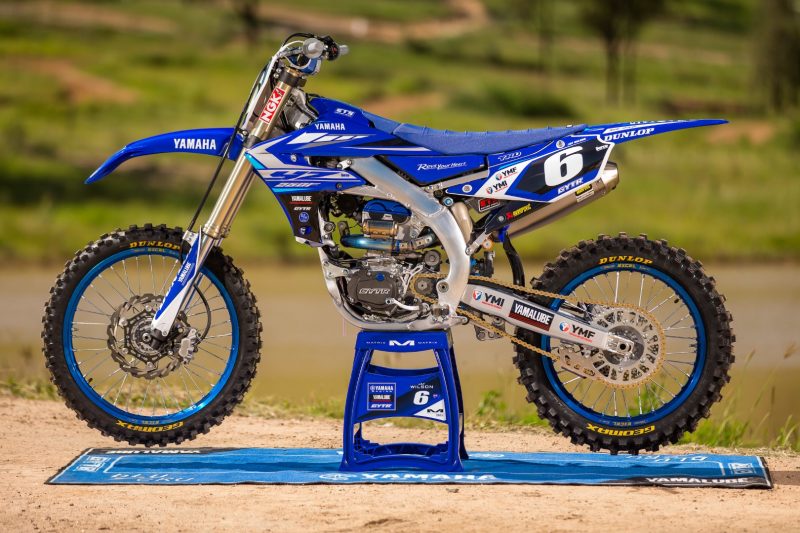
Yamaha Racing has a plethora of YZ250F’s in their racing stable of teams. Across the four teams, Yamaha Junior Racing, WBR Yamaha, Yamalube Yamaha and Serco Yamaha, there is a varied way of developing the production bike as it is massaged into a race weapon.
Each of these teams come at bike development in a different way. For Yamaha Junior Racing, development is minimal as riders learn the craft of racing on the bigger capacity bikes and the need for a highly tuned bike isn’t as important as those at the top of the pro ranks. For WBR Yamaha, they are a shop based team that use the products they sell and recommend over the counter. Racing with their products gives them an intimate knowledge of the strengths and weaknesses that they can pass onto their customers.
Serco Yamaha are the importer and distributor of performance products and use their race team as a vital marketing tool. The performance of those products and parts is very public and they are given the acid test each and every weekend by the best 250cc riders in the country while Yamalube Yamaha Racing is a complete in house team using Yamaha’s own GYTR product range.

Yamaha Junior Racing
The performance of the standard YZ250F has been the bench mark in the 250cc category for some time. The already high level of bike means that the need for performance gains for younger riders is minimal and the focus is spent on fine tuning the bike to rider as far as comfort and suspension goes.
Starting with the standard bike, motor development is based on the use of GYTR parts to enhance the power. A GYTR from DRD is bolted up, the airbox is opened and the use of a GYTR or Unifilter used to increase airflow and for the riders near the top of the tree, a flowed head adds more power again. Then the use of a race performance fuel like ETS MA-3 100 or VP Roo 100 to spice things up.
In the chassis or suspension department, riders start with the basics. Getting the right bend handlebar and the mounts in the right spot is vital. Suspension is a matter of getting the spring rates right for the individual rider. Using the basic measurements of 105mm ride height matched to 35mm of ride height. If you can’t get those measurements then you are in need to talk with your suspension guy to get that dialled in.
YJR Bike Spec
Head: Production Flowed
ECU: Production
Cams: Standard
Piston: Standard
Exhaust: GYTR by DRD
Airfilter: Unifilter
Sprockets: JT (13-50)
Chain: DID ERT3 520
Engine Covers: GYTR Engine clutch and ignition
Brakes: Standard
Triple clamps: Standard
Tyres: Dunlop
Tubes: Dunlop Heavy Duty
Graphics: SPP
Wheels: Standard

WBR Yamaha
WBR Yamaha are a Victorian dealer who are passionate about racing. They raced, their customers race and now they run their own national team that show cases not just the products they sell but also the workmanship and skill of their in shop mechanics. WBR Yamaha recently gave a very detailed look into the race bike built for Maximus Purvis, you can read it at https://bulknutrients.wbrmotorcycles.com.au/what-does-it-take-to-build-a-national-level-race-machine/
As stated in their story, WBR Yamaha tried many parts that you what many would see as exotic or high end but found that the claims didn’t make the gains and often referred back to the OEM parts. In the end, the object is to tailor the bike to suit the rider and with a rider like Purvis, who races for the New Zealand JCR Yamaha team, the development of the bike is continuous as both teams share information.
WBR Yamaha Bike Spec
Head: Flowed production
ECU: GET with data logger
Cams: GYTR
Piston: GYTR
Exhaust: Pro Circuit
Airfilter: Twin Air Intake and filter
Sprockets: JT (13-49/50)
Chain: DID ERT# 420
Engine Covers: GYTR Clutch and ignition
Brakes: GYTR front brake line / Braking rotors
Triple clamps: Standard
Tyres: Dunlop
Tubes: Mousse
Graphics: MX Ink
Wheels: Zeta hubs on standard spokes and rims

Yamalube Yamaha Racing
Being a team housed internally at Yamaha, the majority of the performance based parts for this bike come directly via the GYTR range. Over the time, GYTR have progressively added more and more items to their range and with more coming for the 2021 model, they will have a comprehensive line up to complete your bike from top to bottom.
Alongside where the Yamalube Yamaha team are housed, is the Yamaha Road Racing Team and their resident engine guru, Kevin Marshal takes care of the head work. Kev flows the head for the team and has done for several years. The rest of the package is from the GYTR catalogue. The Akrapovic exhaust, the engine covers and the airfilter are all GYTR items.
Throw in some ETS fuel, some in house mapping via the standard ECU and you have one of the most production based bikes on the MX2 grid, but one that is often near the front in the hands of Jay Wilson.
Suspension wise, Jay runs heavier fork springs and the standard shock spring matched to some minor tweaks to the valving. Jay will then use the fork height to fine tune the handling to suit the track or conditions.
A more detailed report on: https://www.yamaha-motor.com.au/discover/news-and-events/news/racing/2020/may/race-bike-rundown
YYR Bike Spec
Head: YRD Flowed
ECU: Production
Cams: Standard
Piston: Standard
Exhaust: Akrapovic
Airfilter: Unifilter
Sprockets: JT (13-49)
Chain: DID ERT3 520
Engine Covers: GYTR Engine clutch and ignition
Brakes: Standard
Triple clamps: Standard
Tyres: Dunlop
Tubes: Dunlop Mousse
Graphics: SPP
Wheels: Standard

Serco Yamaha
Serco imports and distributes a vast range of high end products in the motorcycle industry. Some of them are directly related to racing while others are for the motorcycle, road or off road, in general. Outside of the Yamaha products on their bikes, the rest are all from the Serco Yamaha shelves and included everything from Yoshimura exhausts to high performance cams and pistons to brake components.
A more details report on the Serco YZ250F can be found at: https://www.yamaha-motor.com.au/discover/news-and-events/news/racing/2020/august/race-bike-rundown
Starting from the top, Serco run a No Toil Airflow Kit that is sees the mesh removed and the airfilter design different to OEM to allow better air flow. They also use a CRM carbon airbox lid which is much higher and allows better airflow. The head is flowed while the standard cams are retained. Serco have tried several different cam settings but settled on OEM for across the board performance. This is finished with a GYTR high compression piston, a Yoshimura exhaust, a Vortex ECU and all fuelled by VP R00 100.
The chassis and suspension also see several changes. The most eye catching is the carbon fibre throughout the bike as well as the titanium bolt kit used. Both reduce weight of the bike.
Other changes include the EZE triple clamp and suspension lowering link, a taller seat also fitted to give the rider a more aggressive position on the bike and the Galfer brake components. Looking at the Serco bike makes for exotic viewing as there is plenty to admire on it.
Serco Yamaha Bike Spec
Head: Serco Flowed
ECU: Vortex
Cams: Standard
Piston: GYTR
Exhaust: Yoshimura
Airfilter: No Toil
Sprockets: Pro Taper (13-50)
Chain: Pro Taper
Engine Covers: GYTR ignition / Hinson clutch
Brakes: Galfer
Triple clamps: EZE
Tyres: Dunlop
Tubes: Dunlop Mousse
Graphics: SPP
Wheels: EZE
Top 10 Tips for your YZ250F
1. Grease everything.
Doesn’t matter if your bike is new or old, keep it greased and well-lubed up for ease of maintenance. Head stem bearings, suspension bearings, rear brake pivot, clutch and front brake levers. Keep it all greased for smooth action and easy use.
2. Routine Maintenance
It should go without saying but regularly cleaning your bike, servicing your airfilter and changing oil and oil filters should be done religiously. Clean the bike properly by taking the plastics off and giving it a good wash, clean and service the airfilter every ride and do your oil and oil filter regularly. Basic maintenance goes a long way to owning a reliable bike.
3. Run a 2.0kg radiator cap (OEM 1.1kg)
Most racing bikes run warm too hot. When they are under heavy load because the conditions or the surface, they can quickly get to a point where heat is an issue. Run a heavy duty cap with up the boiling point by around 10degrees and combine that with a good coolant and clear airflow and heat shouldn’t be an issue.
4. Holeshot button
You can’t enter a race or be a serious racer, without a holeshot device. They are an essential tool of racing that no rider leaves home without. With the power now available from a 250F, drilling the button down more the usual 100mm is common. For motocross on dirt starts, 120mm is common, while the mesh gates of SX can see them down as far as 145mm.
5. Heavy Duty Tubes
Doesn’t matter how much you do to your bike, if there is no wind in the tubes, you aren’t going to win anything. The OEM tubes are thin, light and easy to puncture, so investing $20 in a heavy duty tube, front and rear, adds some peace of mind and should be the minimum required for any racer.
6. Race Gas works
The days of bolt on parts making a massive difference to your bike are slowly diminishing. And those parts that do make big gains, often have an expensive maintenance schedule. Simply by pouring a high quality race fuel into your bike you will get around a 1.5 hp gain in a 250F and also a much sharper throttle response.
7. Mapping
There is power in mapping. The older style plug in Power Tuner had roughly a 10% scoop of adjustment on your fuel and ignition. The new phone app tuning is now around 20% and the right mapping can produce gains that show up on a dyno. There a million maps and recommending one can be difficult as it is dependent on so many things, so google a few up and give them a go.
8. Airbox
Every motor loves clean air. The design of the YZ motor even more so and the more air you can get to it, the higher performance you get but it must be clean air. Simple things like running a after market filter like a Rush 02 will increase flow. From there you can look at taller airbox lid like the ones made by Cycra or finally run a Twin Air Power Flow airfilter kit for good gains. Taking the mesh out of the filter frame isn’t something recommended on this bike.
9. Exhaust
In years gone by, an aftermarket exhaust was always near the top of the to do list when upgrading a bike’s performance. Now days, and this is across most brands, the production exhaust is very good, and the gains found in exhaust aren’t as significant as they used to be. Power is more shifted than gained with a lot of exhausts these days so do some research on the style of power you want before purchasing an exhaust.
10. Clean and dry connectors
Every time the bike has been in contact with water, make the effort to clean out any and all of the connectors, dry them and clip back into place. Dirt and water are your electrical enemies so the cleaner and drier you keep them, the better your chances are of not having any electrical issues.
Bonus tip
11. Graphics
You can’t ride without stickers. It’s impossible! Get yourself a nice looking kit and that will clearly add hp to your bike and take seconds from you lap time.

